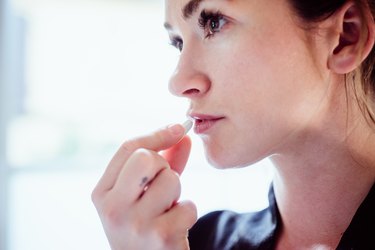
Popping an ibuprofen is one of those no-biggies. You have a headache? Ibuprofen. Sore muscles? Ibuprofen. Period cramps? Ibuprofen.
Ibuprofen falls under a class of medications called non-steroidal anti-inflammatory drugs (NSAIDs). Along with ibuprofen (Advil, Motrin), aspirin and naproxen (Aleve) are other common NSAIDs.
Video of the Day
Video of the Day
And while they're easily available over-the-counter and are safe, they're not risk-free. It is possible to overdo it with these painkillers, and you could do so without realizing it.
NSAIDs are found in several other OTC products, so if you're popping multiple meds, you might inadvertently be overdosing — and putting yourself at risk for some pretty dangerous side effects.
In fact, taking multiple medications that (unknowingly) contain the same actives is likely one reason doctors see more hospitalizations due to stomach ulcers and GI bleeding in the winter months, Dallas-based gastroenterologist Byron Cryer, MD tells LIVESTRONG.com.
During flu season or a COVID-19 infection you might pop cold and flu meds to relieve your symptoms without realizing these tend to be combination medications, meaning they contain a cocktail of active ingredients, some of which are NSAIDs. If you take them along with a painkiller like ibuprofen, you could be doubling up on dosage.
That's not great for your digestive system.
"The stomach produces substances called prostaglandins that protect it from injury. NSAIDs block prostaglandins, and so they lower the production of these protective substances," Dr. Cryer says.
With a decreased barrier, acid — normally present in the stomach — can irritate the lining of the stomach, leading to ulcers and bleeding should you take too much or take them too often.
How to Prevent Overdosing on NSAIDs During Cold and Flu Season
First, you'll want to read labels on anything you're buying at the drugstore and then taking at home. "Look for aspirin, ibuprofen or naproxen," Dr. Cryer says.
There are many meds that will contain these, but also look out for these three OTC medications that may be especially surprising:
- Excedrin products:
- Excedrin Extra Strength and Excedrin Migraine are combinations of acetaminophen (Tylenol), aspirin and caffeine
- Excedrin Tension Headache contains acetaminophen and caffeine
- Excedrin PM Headache contains acetaminophen and aspirin
- Alka-Seltzer Original contains aspirin
- BC Powder's Fast Pain Relief product line and Goody's Headache Powder are powdered aspirin/caffeine (BC) or a combination of aspirin, acetaminophen and caffeine (Goody's)
- Some multi-symptom cold and flu medications or sinus congestion/pain medications — many of these use acetaminophen (Tylenol) but some contain ibuprofen
Here's one example, Dr. Cryer says, of how this can all work: You have the flu. You take aspirin to deal with the fever, then take some Alka-Seltzer to deal with upset stomach, and maybe you're already regularly taking Motrin (ibuprofen) for back pain. That's taking an NSAID on top of an NSAID with a side of NSAID, he says.
Related Reading
How to Safely Take NSAIDs
It's important to pay attention to the dosage and time listed on the label, which will keep you in a safe range.
"OTCs are safe, but that does not mean you can take as much as you want," Dr. Cryer says. "As with any medication, the likelihood of side effects goes up with the dose, especially NSAIDs," he says.
Read the label. If it says to take two tablets in 6 hours, that's what you have to stick with. Taking more (say three tablets) or sooner (in 3 or 4 hours) will increase your risk of unhealthy effects.
If you find your symptoms come roaring back sooner and you're a bag of misery, you don't have to suffer. When you reach the maximum dose or the time limit hasn't hit yet, you can take acetaminophen (Tylenol), which is not an NSAID and is metabolized differently in the body.
Lastly, know the number of days it's safe to take this without doctor supervision, Dr. Cryer says. The label will point this out, but it's often 10 days. After that amount of time, if you find you still need the medication, talk to your doctor.
Is this an emergency? If you are experiencing serious medical symptoms, please see the National Library of Medicine’s list of signs you need emergency medical attention or call 911.